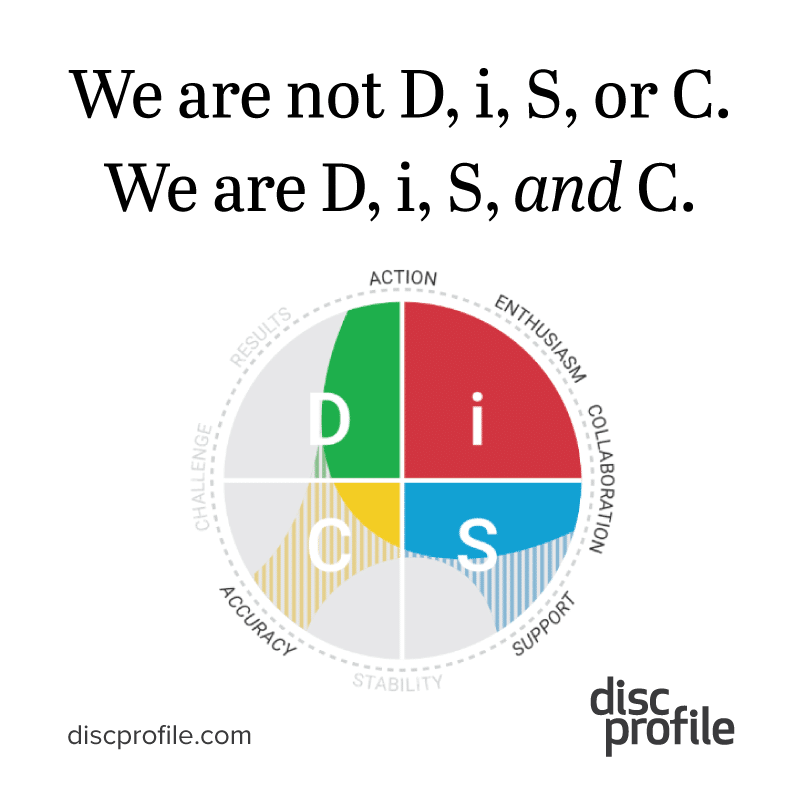I’m a C. Would that make me a better candidate for an accounting job than an S? It’s obviously not enough information to make that kind of decision. And I can tell you I’d be a mediocre accountant—at best. Even though I love charts and being right, I have no interest in that field and no proficiency in it. It’s not the right challenge for me.
I’m an iD. I love change and I like to move fast. I’m good at engaging with people. I should be good at sales, right? I am! But I’m not good at cold calling; I’m only good at closing the sale. If you compared my profile to one of your successful “hunters,” you might think I’d be highly successful, and we could both be disappointed.
DiSC® is not for pre-employment screening
DiSC® is not recommended for pre-employment hiring screening because it does not measure a specific skill, aptitude, or factor specific to any position. DiSC instead describes one’s work behavior patterns or style.
If you’re confident that there are personality traits that will influence someone’s success in a specific job, you should instead use a selection tool like PXT Select that’s been validated for hiring and includes personality as well as cognitive assessments.
DiSC is a user-friendly, high-credibility, low-cost tool used by many during the hiring or onboarding process. Be sure to use it responsibly.
Our most popular DiSC product used during the hiring and onboarding process is the Everything DiSC Workplace Profile.
How can DiSC be used appropriately?
If you are using DiSC during the hiring process, make sure it is just one of the factors influencing your decision. For example, you can use the assessment to craft interview questions that will allow you to get to know the candidate’s work style better.
Does the DiSC profile match how the candidate presents when you meet them? If not, this may inform what you’d like to ask them in future interview rounds.
Is it likely that the job duties will take the candidate outside their comfort zone? If so, then again you might want to tailor some of your interview questions toward the candidate’s resiliency and goals, and judge those against your organization’s needs.
Does the candidate bring a style to the team that is currently missing? If so, will the team manager be able to help the candidate integrate into the team? Will the team accept them? Is the team in need of and ready for internal challenges?
Do you anticipate challenges for this candidate because of their preferred behavioral style? If so, and the person is hired, you might want to work with their manager a bit before their first day on the job. For example, perhaps the team is highly energetic and social, but the new hire is not. You might want to ask the manager to consider other ways the group can bond and give the new hire time to engage with everyone more slowly than the group might prefer.
Read more: DiSC for onboarding
Have you checked your own bias? Do you or your organization tend to hire people of similar types? Do you just find it easier to interview certain types? Do you make assumptions about the leadership abilities of a D? You know that two people who receive a strong D profile might appear to approach a problem in a similar way but get two entirely different outcomes. So how can you get past your own bias or help a hiring authority get past theirs? Are you hiring to meet business goals or to remain in a comfort zone of your own?
Sharing the profile
We’ve been surprised to learn that some hiring managers do not share the candidate’s profile with the candidate. Keeping the profile to yourself is missing an opportunity to offer your candidate something more to make them feel good about you. It can make you stand out as an employer who is engaged with its employees. Frankly, keeping the profile to oneself is a little creepy and makes DiSC seem more like a lie detector test.
You can also use DiSC to explain your organization’s or department’s culture to a candidate. If all the employees have taken the assessment and you have a Group Report handy, it can help you quickly describe how the group behaves. It can complement documents you might provide on a department’s goals, mission, or plans.
Remember that the Everything DiSC® model is a circle
When you look at a candidate’s Everything DiSC Workplace® profile, you’ll see that a bit of each style is represented within the circle. Each person has the ability to adapt their style. The profile does not tell you how good the person is at stretching into different styles. You need to determine communication skills, people skills, technical skills, and leadership skills through other techniques.
If you see a profile in which it looks like the candidate might struggle with displaying personal warmth, for example, you can use that information to ask the candidate to tell you more about how they’ve used that trait to make a sale. You can look for how adaptable and flexible the candidate is.
DiSC gives you additional data you can use to structure your interviews and add to the other data you gather during your hiring process. It should never be used as a single or shorthand indicator of a candidate’s suitability for a job.


